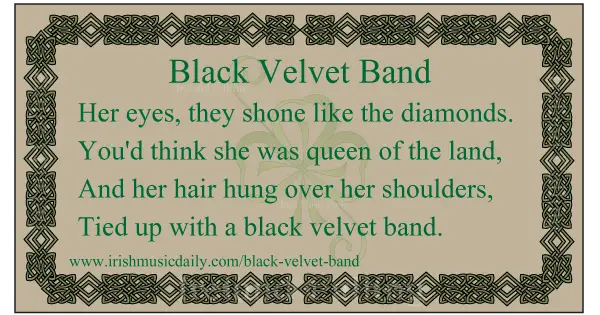The Black Velvet Band is one of Ireland’s most dramatic and popular folks songs. There are several versions to be found all across the world from Ireland to America and on to Australia. They vary in detail but they all tell the same basic story.
A young man goes walking through the town when he chances upon a beautiful woman whose hair is tied up with a black velvet band. He takes a stroll with her, little suspecting the trouble she is going to cause him.
A gold watch she took from his pocket

As they walk along, they meet a gentleman passing by. The young man immediately senses that the woman plans some mischief by “the look in her roguish black eye”. His fears prove well grounded because the woman steals the gentleman’s gold watch and puts it into the young man’s hand.
Despite the young man’s misgivings, the song makes no reference to him trying to stop her or trying to distance himself from her. Instead he seems to accept his fate. The only resistance he can offer is to wish her bad luck. Perhaps he is too smitten with her beauty to do more.
Betrayed by the Black Velvet Band
The young man is hauled before the courts the next morning where the judge decides that the case against him is proven. Some versions of the song have the victim identifying the jewellery but most just declare that the young man is found guilty.
The sentence is seven years penal servitude, even though the judge acknowledges that the young man was “betrayed by the black velvet band”.
Beware of ‘them’ pretty colleens

The song ends with the young man issuing a warning to others. He tells them to beware of pretty young colleens when they are out on the town. He says some women will ply them with strong drink until they are unable to stand.
When they are drunk they will led into some mishap and the next they know, they will be bound for Van Diemen’s Land – modern Tasmania.
Transportation was a common punishment

Transportation to the British colonies such as Australia or Van Diemen’s land was a much used sentence by the British and Irish courts in the 18th and 19th centuries. Seven years “penal servitude” as dished out in the Black Velvet Band was commonplace.
It served two purposes for the British establishment: it saved the expense of putting criminals in British jails and it also provided cheap labour for the emerging British Empire.
Perhaps the most shocking element of the whole procedure was the fact that long penal servitude sentences were handed down for even the most trivial of crimes such as petty theft, even if it was the theft of a loaf of bread to feed a hungry family.
The Hat with the Velvet Band
Ironically, perhaps, transportation sentences helped to spread songs like the Black Velvet Band all across the world where they were modified and reshaped to suit their new environment.
One variation known as the Hat with the Velvet Band became popular with Australian and Tasmanian fishermen in the early 19th century. In America, a version of the song emerged called the Girl in the Blue Velvet Band. There is also another version from Ireland called the Black Ribbon Band, which tells much the same story but is set in Tralee rather than Belfast.
Black Velvet Band
Black Velvet Band videos
Black Velvet Band lyrics and Chords
Variations of the Black Velvet Band
The origins of the song are uncertain but it is very old. Like many old traditional songs, especially those that have travelled the globe, the Black Velvet Band has undergone several changes and so has several versions.
In some versions, the girl merely hands the young man some jewellery that she had already stolen.
In other versions, the young woman is working as a barmaid and steals the jewellery from a customer in the bar.
Is the warning about alcohol an afterthought?
One interesting anomaly about the Black Velvet Band is that nearly every version ends with a warning about women plying men with alcohol and getting them into trouble. Yet in no version, certainly no widely used version, does the woman in the song use drink to trick the young man into being an accomplice.
It’s as though the warning is tagged on as an afterthought because it has nothing to do with the story.
